What is the best way to move a wheelchair into an elevator? Most people would probably say, “just push it in carefully!”, but simply pushing it in hardly qualifies as the best way.
I’ve spent years wheeling patients and medical equipment up several floors, and I have some insights on the best way to do it.
The methods I’ll explain have worked for the people with disabilities in my life, no matter what type of elevator they were using. Read more!
Key Takeaways
- The person who is helping you can either enter the elevator while facing the front or turn and pull in the wheelchair with your back to the elevator.
- The above procedure will still work for you when stepping out of the wheelchair. To make it easier to get out of the elevator, always ask everyone else to step out before leaving (2).
- Choose the bank of elevators you’re sure serves your destination floor.
- Measure the wheelchair travel speed accordingly when using an electric wheelchair.
- Note how high or low the elevator door is relative to the floor or ground surfaces.
Table of Contents
How To Move a Wheelchair Into an Elevator?

Elevators are an excellent way to navigate tall skyscrapers in this vastly developed world.
The problem is that though these places usually have an accessible route, it’s difficult for most wheelchair users to find it.
Some buildings have elevator operators to help someone get to the destination floor. But most of the time, the operators struggle to get a wheelchair from a ground floor service elevator to the destination floor.
There are many methods you can use to get a wheelchair in an elevator. Let’s look at all of them.
1. Getting a Wheelchair Into an Elevator — Attendant Operation Wheelchair
Any wheelchair user can get into any wheelchair-accessible elevator with a little help. This method is for wheelchairs operated by an attendant.
1. Press the button to call the elevator. When the elevator arrives, turn your back to the elevator entrance.
2. Align the front wheels of the wheelchair to the middle of the elevator before slowly backing into the elevator.
3. To get out of the elevator, wait for the person closest to the door to get out. Repeat the style you used to push into the elevator. Your back should be turned to the entrance before pulling the wheelchair out of the elevator.
This video shows you how to do it.
That should help you push a wheelchair into any elevator in a residential or commercial building.
With an attendant, you don’t have to worry about the buttons to press when you get to the destination floor.
Also Check: How to Push Someone in a Wheelchair?
2. Pushing A Wheelchair Into an Elevator — Without Attendant Help
Most wheelchair users I know are usually afraid of venturing into taller buildings by themselves.
Some wait for the building attendant to help them enter the traction elevators. But you won’t always have someone to help.
You can get your wheelchair into an elevator alone if you follow all the essential safety requirements when pushing yourself in.
Here is how to do this safely in a few steps.
1. When getting a wheelchair in an elevator alone, you can decide to enter front or back-facing. Going in front-facing will need you to give the wheelchair a significant push to get into the elevator.
2. When going backward, position yourself at the center of the elevator entrance, then push yourself back into the elevator like in the following video.
That wasn’t so hard, was it? It becomes effortless if you’re using an electric propelled wheelchair.
One thing you need to watch out for is any drops or rises from the ground surface to the elevator before entering (1).
Also Check: 10 Best Manual Wheelchairs for Outdoor Use
The unfortunate man in the video below did everything wrong regarding getting into a commercial elevator. And, fell out of a wheelchair. So here’s what you shouldn’t do.
The Best Way To Enter an Elevator on a Wheelchair
The two ways above are okay, provided you take it slowly for each step.
If you aren’t confident that you can get in a commercial or residential elevator alone, it’s wise to have someone help you.
But going it alone will fuel your inner feeling of independence. You only have to understand the type of elevator you’re using to avoid any accidents.
Things To Avoid When Moving a Wheelchair Into an Elevator
Elevators are the most preferred route between stories, not only for individuals with disabilities but also for abled people.
Now, most elevators have their safety features to ensure safe use for all. But there are some things to avoid when moving into an elevator.
1. Getting Into Already Full Elevators

Of course, getting into a packed elevator is against elevator etiquette. It will also make it harder for you to get inside. Ideally, getting into the elevator with as few people as possible would be better.
2. Moving Too Far From the Alarm Button When Alone
Don’t push yourself too far from the visible alarm buttons for elevator service when alone. In an emergency, it’s easier to reach such controls when close enough.
3. Facing Backwards in the Elevator
While you can enter an elevator facing the front, then turn later, that can be challenging if it’s a fully packed elevator. Commercial elevators are usually full of people and will be too full to turn once you get in.
Try to use alternative methods to ensure you don’t inconvenience other users.
4. Not Asking for Help
If getting into an elevator alone, ask for help whenever available. Unlike residential dwelling units, some commercial elevators have an elevator operator to help.
FAQs
Can I use a wheelchair in an elevator?
Why not? Individuals with disabilities can also use elevators. You only need to know how to get the wheelchair into the elevator.
How big should an elevator be for a wheelchair?

The ADA advises that building elevators be at least 36 inches (3). That is ideal wheelchair space for most wheelchairs. Knowing the dimensions of your wheelchair will be of immense help.
Can I buy an elevator for my residential home?
Oh yes, you can buy an elevator for your residential home. But you have to be wary of the elevator costs, which are usually relatively high.
Conclusion
What is the best way to move a wheelchair into an elevator? There are many methods and knowing the direction of travel will help you determine what works for you.
Keep in mind that different elevators could need different styles. For example, you can’t use the same technique you’d use for regular elevators when entering a shaftless elevator.
Once in an elevator, always stay close to the safety devices if alone. Also, always ask for help to get your wheelchair into an elevator whenever available.

What other ways do you know that a wheelchair user can use to get into an elevator? Please share them with us in the comments below.
References
- 1. Northwest Regional Spinal Cord Injury System. Using a Wheelchair or Scooter in an Elevator Preparation for Elevators [Internet]. Available from: https://sci.washington.edu/info/forums/reports/WC%20and%20scooter%20in%20elevator.pdf
- 2. Wolgin F. The Nursing Assistant’ 2005 Ed.2005 Edition [Internet]. Google Books. Rex Bookstore, Inc.; 2005 [cited 2022 Sep 27]. Available from: https://books.google.co.ke/books?id=Rg8qVs5Hx-MC&pg=PA169&lpg=PA169&dq=how+to+push+a+wheelchair+into+an+elevator&source=bl&ots=Xjmt5ptN-j&sig=ACfU3U0JToDdiwDAprdgk
- 3. ADA. The ADA National Network Disability Law Handbook | ADA National Network [Internet]. Adata.org. 2019. Available from: https://adata.org/guide/ada-national-network-disability-law-handbook





